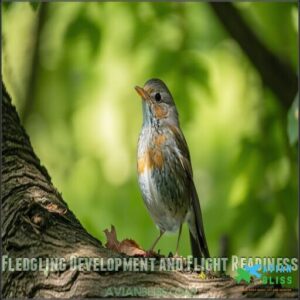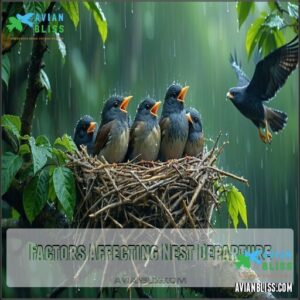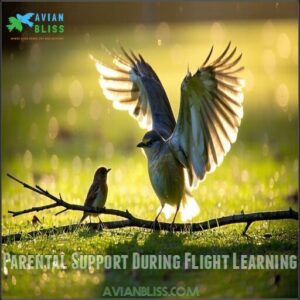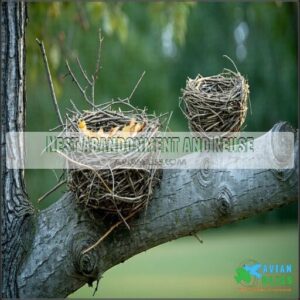This site is supported by our readers. We may earn a commission, at no cost to you, if you purchase through links.

Tiny songbirds, like sparrows, are quick growers and might leave in about two weeks, while larger birds, such as hawks, may stick around longer.
During this time, the nest is like their playpen, where they’re fed, kept warm, and grow strong enough to spread their wings.
Factors like weather or food availability can influence how long they stay.
By the time they fledge, they’re ready to face the bigger world—but their parents often stick close, offering guidance.
Things get exciting after that!
Table Of Contents
- Key Takeaways
- Baby Bird Nesting Basics
- How Long Baby Birds Stay
- Nesting Period Variations
- Baby Bird Development Stages
- Factors Affecting Nest Departure
- Nesting Period and Departure
- Caring for Baby Birds
- Baby Bird Flight Development
- Post Nesting Care and Survival
- Nest Abandonment and Reuse
- Frequently Asked Questions (FAQs)
- How long do birds stay in the nest?
- When do baby birds leave the nest?
- How long do baby robins stay in the nest?
- How long do altricial birds stay in the nest?
- How long do songbirds stay in the nest?
- Do baby birds return to the nest at night?
- How long does it take for baby birds to fly out of the nest?
- When do birds leave the nest?
- Can a baby bird leave the nest?
- How long do birds stay near their parents?
- Conclusion
Key Takeaways
- Baby birds usually stay in the nest for 8-21 days, depending on their species and how quickly they grow.
- Smaller birds like sparrows leave in about two weeks, while larger ones like hawks might stay longer.
- Altricial species, like songbirds, hang out in the nest until they’re fully developed, while precocial birds, like ducks, leave almost immediately after hatching.
- Weather, food availability, and predators impact how long baby birds stay before they’re ready to fledge.
Baby Bird Nesting Basics
You’ve probably seen birds buzzing around with twigs, but there’s a lot more to nesting than meets the eye.
From sturdy sticks to spider silk, birds carefully craft homes that keep their eggs safe and snug.
Materials Used for Nesting
Birds get creative in terms of gathering nest materials.
From twigs to spider silk, birds weave nature’s finest resources into safe, snug sanctuaries for their growing families.
Twigs and leaves form the nest framework, while mud and saliva act as natural adhesives.
Spider silk strengthens the structure, and some species even use pest deterrents like herbs or snake skins.
To make certain safety, birds often seek safe nesting materials like untreated grass.
Material accessibility is key—whatever birds find handy becomes part of their unique bird nest architecture during construction, ensuring a safe and creative approach.
Nesting Locations and Environments
You’ll find bird nests in fascinating places.
Elevated locations like trees, cholla cacti, or even cliffs offer safety from predators.
Birds get creative, using spider silk, sturdy twigs, and nest adhesives like mud and saliva.
Some species reuse old nests, saving time and effort.
Consider a stable mounting solution for birdhouses.
Bird nest sites vary by species, guaranteeing a cozy spot for their nesting period.
- Trees, cacti, or cliffs guarantee safety
- Nest materials include twigs and silk
- Some birds adapt old nests for reuse
- Location depends on predators and food
Nest Building Techniques
Nest building is an artful science. Birds start with material selection, weaving twigs, moss, or grass into their nest designs.
Mud and saliva act as adhesives, while silk reinforcement adds strength. Nest architecture varies—some birds repurpose old nests, saving energy.
To find the right materials, many birds will gather nesting supplies for comfort and safety.
These bird nest construction techniques create snug homes, ensuring baby birds stay safe, cozy, and protected during their vital early days.
How Long Baby Birds Stay
The time baby birds spend in the nest depends on whether they’re altricial or precocial.
Altricial species, like songbirds, are born blind and helpless, staying in the nest longer to develop. Precocial birds, like ducks, hatch ready to hit the ground running—or waddling—and leave within hours.
Here’s a breakdown of nest duration:
- Altricial Birds: These nestlings need 8–21 days before fledging. Smaller birds, like sparrows, leave sooner than larger ones.
- Precocial Birds: Their nest departure happens almost immediately since they hatch with feathers and open eyes.
- Incubation Length: Songbird eggs take 11–14 days, while larger birds might need a month.
- Parental Influence: Parents control feeding and encourage fledging in stages.
- Post-Fledging Dependence: Even after leaving, fledglings often rely on parental care for weeks to learn survival skills.
Nesting Period Variations
You’ll find that the time baby birds spend in the nest varies widely depending on the species.
Factors like size, environment, and food availability all play a role in how long these little ones stick around, which can be considered a complete concept in understanding their development.
Species-Specific Nesting Periods
Depending on the bird species, the nestling period varies widely.
Altricial nesting birds like songbirds fledge in 10-14 days, while precocial departure species, such as waterfowl, leave immediately.
Raptor nesting, like bald eagles, takes much longer, with a nest duration of 70-100 days.
Songbird fledging happens sooner than waterfowl incubation finishes, highlighting how each fledging time depends on bird nestling development.
Environmental Factors Affecting Nesting
Bird nesting isn’t just about twigs and feathers—it’s a delicate balance shaped by environmental factors.
Climate change shifts nest timing, habitat loss reduces safe spots, and pollution impacts resources essential for bird development.
Predator density also affects nestling periods and fledging time.
Even small changes in temperature or rainfall can make nests either havens or hazards for young birds.
Food Availability and Nesting Periods
When food abundance is high, nestling periods shorten since parents meet dietary needs faster, leading to quicker bird nestling growth.
Regional variations and climate impact food availability, influencing breeding seasons and bird feeding patterns.
For example, areas rich in insects let birds feed nestlings more efficiently. In poorer conditions, nestling periods stretch as birds struggle to provide for their young, which is influenced by the overall food availability.
Baby Bird Development Stages
You’ll notice baby birds go through three key stages: hatchlings, nestlings, and fledglings.
Each stage is packed with fascinating changes, from growing feathers to mastering their first awkward attempts at flight.
Characteristics of Hatchlings
Hatchlings, whether altricial or precocial, differ greatly in appearance and independence.
Altricial baby birds, like robins, hatch naked, blind, and completely dependent on parents. In contrast, precocial hatchlings, like ducks, are fluffy, alert, and mobile.
Sensory development is slow for nestlings, with ears and eyes opening within days.
Early vocalizations help signal needs, ensuring constant care during the nestling period, which is crucial for their development and survival.
Developmental Milestones of Nestlings
Nestlings grow fast, transforming from their awkward hatchling appearance into tiny birds ready for the fledgling stage.
Rapid growth turns nestlings from fragile hatchlings into feathered fledglings, ready to take their first adventurous leaps into the world.
During this time, you’ll notice:
- Feather Development: Fluffy down gives way to real feathers for warmth and flight prep.
- Sensory Development: Eyes open, and hearing improves rapidly.
- Motor Skills: Wing flapping and stretching boost strength.
These avian growth milestones are fascinating!
Fledgling Development and Flight Readiness
The fledgling stage is like a bird’s "learning to drive" phase.
Feather growth and muscle development are signs they’re preparing for flight independence.
Flight practice starts with wobbly hops and short flaps.
Parental guidance plays a huge role as bird fledglings improve coordination.
It’s fascinating how nature equips them for this adventure.
| Stage | Activity | Key Detail |
|---|---|---|
| Early Fledging | Resting | Feathers grow for stability. |
| Mid Fledging | Hopping & Flaps | Practice strengthening wings. |
| Late Fledging | Short Flights | Parents observe & encourage. |
Factors Affecting Nest Departure
When baby birds leave the nest, it’s not just about timing; weather, food, and predators all play a role.
Parental care adds the final push, ensuring fledglings are ready to face the world.
Weather Conditions and Nest Departure
Weather often dictates a bird’s fledging schedule.
Temperature effects can either accelerate or delay departure—cold snaps might keep nestlings nestled longer for warmth.
Rainfall impact adds challenges; drenched feathers make flight tricky.
Wind influence is another hurdle; strong gusts can endanger wobbly first flights.
Storm risks play a major role, prompting parents to wait for calmer days.
These seasonal changes are nature’s way of prioritizing bird nest survival, ensuring nestlings fledge safely and face storm risks in a more controlled manner, which is crucial for their nest survival.
Parental Care and Encouragement to Fledge
Parents play a huge role in helping baby birds leave the nest. Through feeding fledglings and showing them roosting habits, they teach the skills needed for survival. Encouragement comes with gentle nudges—sometimes literally! Male bluebirds, for example, often outpace females feeding their young.
- Parental collaboration keeps predators at bay, ensuring safety during fledging.
- Skill learning includes teaching bird nestlings to forage and fly through short flights and flapping.
- Predator defense helps fledglings understand hiding spots and signals danger isn’t far away.
The process of teaching young birds to fly and forage is crucial for their development, and parents play a significant role in this process.
Nesting Period and Departure
You might be surprised how different bird species handle their time in the nest, with some babies staying just days while others linger for weeks.
Understanding these nesting periods helps explain how birds balance safety, growth, and the push to explore the world.
Average Nesting Periods for Different Species
Different bird species have varying nesting periods.
Small songbirds often spend 10 days to 2 weeks in the nest, while larger birds like woodpeckers may stay up to a month.
Precocial species, like ducks, leave their nests almost immediately after hatching.
Meanwhile, altricial birds require intensive parental care, staying longer as they develop strength and readiness for fledging.
Variations in Nesting Periods Due to Environmental Factors
Nest-building isn’t just instinct; it’s survival strategy.
Climate change, habitat loss, and urbanization impact baby birds’ nesting periods, often shifting timelines.
Seasonal shifts may rush or delay nesting, while pollution effects disrupt microclimates inside nests.
Environmental factors influence bird growth rates and nest success.
These adaptations matter—nature doesn’t give refunds, and baby birds need every edge to thrive despite changing conditions.
Songbird Nesting Periods and Departure Times
Songbirds follow a fascinating timeline from egg to flight. With incubation lengths of 11-14 days and synchronized hatching, baby birds grow quickly.
Nestlings depend on constant care before fledging around 2-3 weeks. Altricial development means hatchlings stay put longer, gaining strength for flight.
Nest architecture varies, with birds using diverse materials like twigs and mud. Clutch sizes vary, but parental dedication guarantees fledgling dependence is met before they gracefully take off.
Caring for Baby Birds
If you find a baby bird outside the nest, it’s important to know how to help without causing harm.
Understanding when to step in and when to leave nature alone can make all the difference for its survival.
Locating The Nest and Returning The Baby Bird
If you spot young birds on the ground, start by finding nests nearby.
Gently return nestlings to their bird nest—it’s safe, despite the myth about parental abandonment. Use clean hands or a soft cloth for safe relocation.
Remember that parents won’t abandon their young due to human scent, as explained on the avian bliss.
Avoid nest disturbance to prevent harm. Helping baby birds return home supports their survival and gives them their best chance to thrive.
Contacting a Wildlife Rehabilitator for Guidance
If you find an injured bird or believe you’ve stumbled across an orphaned bird, contacting local rehabilitators is critical.
Wildlife experts handle the bird rescue and rehabilitation process safely.
Here’s how to start:
- Search online for licensed bird rescue centers.
- Note the bird’s location and details.
- Avoid feeding or water.
- Follow instructions carefully.
- Transport responsibly.
Avoiding Unauthorized Intervention and Potential Consequences
Moving a bird nest or handling nestlings can lead to bird abandonment, impacting their survival.
Fledgling observation is fine, but touching them risks legal protections and increases bird mortality.
A disturbed bird nest may be deserted, leaving nestlings vulnerable.
Instead, make certain no relocation risks and avoid bird nest disturbance to support their natural development and safety, and let nature handle the rest, ensuring the survival of the birds.
Baby Bird Flight Development
You’ll notice baby birds gradually preparing for flight as their feathers fully develop and their muscles strengthen.
During this stage, they practice flapping and short flights, building the skills they need to leave the nest successfully.
Physical Development Indicators
Physical development signals when young birds are nearly ready to leave the nest.
Watch for these key signs:
- Feather Growth: Baby birds develop sleek, full feathers replacing their fluffy down.
- Wing Strength: Flapping practices build essential wing muscles.
- Bone Density: Strong bones enable flight.
- Coordination Skills: Improved balance and control prepare them for early flights.
Nature has a checklist!
Flight Practice and Proficiency
Once fledging begins, young birds focus on building flight muscle development through rapid flapping and initial flight attempts.
It’s not graceful—more like a wobbly kite in a breeze.
Post-fledging maneuvers improve as they repeat short flights, practicing predator evasion skills and soaring techniques.
Every flapping leap gets them closer to mastering bird flight skills and increasing their survival chances.
Parental Support During Flight Learning
As bird fledging begins, parents step up their game.
They guide fledglings during flight skill development, showing how to flap, glide, and avoid dangers. Continued parental feeding supports their energy needs while they practice.
Along the way, parents teach foraging skill acquisition and predator avoidance.
Fledglings rely on nearby post-fledging roosting, staying close to guardians for safety during early flight development.
Post Nesting Care and Survival
Once baby birds leave the nest, they’re not quite on their own yet.
Parents stick around to teach them essential survival skills, like finding food and avoiding predators, during this critical stage.
Parental Care After Fledging
As fledglings leave the nest, bird parental care doesn’t stop.
Parents still assist with feeding and teaching survival skills. They protect their young from predators and guide them through the fledging process.
You’ll notice:
- Parents bringing food to scattered fledglings.
- Adults fending off predators near roosting spots.
- Persistent guidance during early flight attempts.
It’s an active extension of nest life, where parents continue to play a crucial role in the development of their young, providing persistent guidance.
Fledgling Survival Strategies
Once they leave the nest, fledglings rely on parental guidance to develop foraging skills and roosting habits.
Predator avoidance is their top defense, often freezing or hiding when threatened.
Parents offer critical post-fledging care, teaching survival strategies like safe perching.
Here’s the fledgling experience at a glance:
| Challenges | Strategies | Support | Outcome |
|---|---|---|---|
| Predators | Freezing/Concealment | Parental calls | Safety |
| Finding Food | Foraging practice | Guided feeding | Independence |
| Coping with Dangers | Continuous guidance | Shelter creation | Longevity |
| Environmental Hazards | Safe shelter use | Roost selection | Resilience |
Avoiding Predators and Environmental Hazards
Keeping baby birds safe from threats like predators and harsh weather is critical for their survival.
Nest camouflage and height play a big role. Parents often use clever tactics to protect their young.
- Use thorny plants to deter predators.
- Choose sites shielded from strong winds or rain.
- Avoid exposed areas visible to predators.
- Rely on instinct to sense nearby hazards.
Nest Abandonment and Reuse
Sometimes birds abandon nests due to predators, disturbances, or poor conditions, leaving you wondering what happens next.
While most birds don’t reuse old nests, a few will renovate them, saving time and energy for their next brood, which is an interesting aspect of their behavior.
Reasons for Nest Abandonment
Sometimes, life throws a wrench into nesting habits.
Predator threats, human interference, and food scarcity often lead to bird nest abandonment.
Parents sense danger or lack resources and prioritize survival.
Nest disturbance, like loud noises or nearby activity, can also spook them.
Poor parental health or bird nest parasites may push them to abandon eggs or young.
| Reason | Impact on Nests | Example | Solution Ideas |
|---|---|---|---|
| Predator Threats | Parents flee | Foxes near nests | Use predator barriers |
| Human Interference | Disturbance causes exit | Construction activity | Keep a safe distance |
| Food Scarcity | Inadequate resources | Extreme drought | Bird-friendly gardens |
| Parental Health | Parents can’t care | Injury or illness | Minimize disruptions |
Nest Reuse and Renovation
While some birds reuse nests, species differences shape this behavior.
Often, nests face material degradation from weather or wear. Nest sanitation is essential—parasite avoidance drives birds to renovate structures or abandon them altogether.
Renovation frequency varies, with some birds adding fresh materials for sturdier nesting habits. Reusing a bird nest saves time and energy, yet painstaking nest construction guarantees safety and comfort.
Cleaning and Maintaining Nesting Sites
If a bird nest is reused, it’s smart to check its hygiene. Remove old debris to improve nest sanitation and control parasites.
Consider using a specialized bird cleaner to guarantee a sanitary environment. Replenish materials like twigs for nest repair if needed.
Predator deterrence can involve trimming nearby cover that hides threats. Bird nest monitoring helps confirm the space remains safe, clean, and ready for new arrivals.
Frequently Asked Questions (FAQs)
How long do birds stay in the nest?
Baby birds typically stay in the nest for 8-21 days, depending on the species.
Smaller songbirds fledge sooner, while larger birds take longer.
Once they’re feathered and ready, they’ll test those tiny wings!
When do baby birds leave the nest?
Think of it like a springboard to freedom—baby birds usually leave the nest, or fledge, after 12 to 21 days.
Smaller species go sooner, while larger ones like woodpeckers may take up to a month.
How long do baby robins stay in the nest?
Young robins stay in the nest for about 13 days after hatching.
During this time, their parents feed them constantly, helping them grow strong enough to fledge.
It’s like baby bird boot camp—nonstop training!
How long do altricial birds stay in the nest?
Parenting altricial chicks is no walk in the park.
They’ll hang out in the nest for 8-21 days, depending on the species, relying entirely on their parents for food, warmth, and protection during this time.
How long do songbirds stay in the nest?
Songbirds, being altricial, usually remain in the nest for 8-14 days after hatching.
During this period, they’re blind, featherless, and totally dependent on parents for warmth and food until they’re ready to fledge.
Do baby birds return to the nest at night?
Baby birds don’t make nightly returns to their nest—it’s a one-way ticket.
Once they fledge, they roost elsewhere, learning essential survival skills like flying and foraging, with their parents keeping close watch.
How long does it take for baby birds to fly out of the nest?
It typically takes baby birds 8 to 12 days to fledge, though some larger species may take up to 3 weeks.
Once they develop feathers and coordination, they’re ready to practice short flights and explore!
When do birds leave the nest?
Birds leave the nest once they’re feathered and can handle short flights, usually between 8 to 21 days depending on species.
Parents stay nearby, coaching their fledglings in flying and foraging, like tiny survival teachers.
Can a baby bird leave the nest?
Rome wasn’t built in a day, and neither are wings.
A baby bird can leave the nest once it’s strong enough to fly, usually at 8-12 days, though larger species might take longer.
How long do birds stay near their parents?
Young birds stick around their parents for about 3 weeks after leaving the nest.
During this time, they learn essential skills like flying and foraging.
Think of it as bird boot camp for survival!
Conclusion
Think of the nest as nature’s nursery, where baby birds prepare for their big debut.
How long do baby birds stay in the nest? It varies—from around 10 days for small species to over 20 days for larger ones.
Factors like species, weather, and food availability play a role. By the time they fledge, most are ready to explore.
Even then, parents stay nearby, guiding their young. You’ve now got a bird’s-eye view of this incredible journey!

















